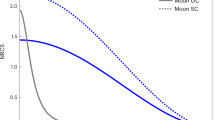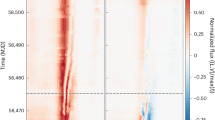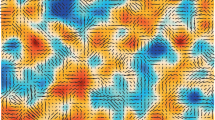Abstract
ROTATION of the plane of polarization (the Faraday effect) of radio echoes from the Moon has been used by Browne, Evans, Hargreaves and Murray1 and by Evans2 to determine the total electron content of the ionosphere. The method is based upon the fact that the plane of polarization of a linearly polarized wave during its double passage through the ionosphere is rotated by an amount:  where ƒ is the frequency of the transmitted wave in c./s., B is the Earth's magnetic field in gauss at ionospheric levels, θ is the angle between the direction of propagation and the Earth's field, δ is the zenith angle of the path, N is the electron density per cm.3 and dh is an element of height in cm. The limits of integration correspond to the region in which the ionization is large enough to make an appreciable contribution to the rotation. The assumption is made that B is constant throughout this region and has a value of 0.5 gauss. The value of the constant in the above equation published by Browne, et al.
1 appears to be in error by a factor of two, although the value given at a later date by Evans2 is correct. The reason for the error is that the angular rotation was taken to be equal to the phase difference between the ordinary and extraordinary rays. The parameter of interest, however, is the displacement from its initial position of the resultant of two vectors, one of which has rotated clockwise and one counter-clockwise. This resultant is displaced (ϕ1 − ϕ2)/2 from its initial position, where ϕ1 and ϕ2 are the absolute values of the rotations of the two component vectors.
where ƒ is the frequency of the transmitted wave in c./s., B is the Earth's magnetic field in gauss at ionospheric levels, θ is the angle between the direction of propagation and the Earth's field, δ is the zenith angle of the path, N is the electron density per cm.3 and dh is an element of height in cm. The limits of integration correspond to the region in which the ionization is large enough to make an appreciable contribution to the rotation. The assumption is made that B is constant throughout this region and has a value of 0.5 gauss. The value of the constant in the above equation published by Browne, et al.
1 appears to be in error by a factor of two, although the value given at a later date by Evans2 is correct. The reason for the error is that the angular rotation was taken to be equal to the phase difference between the ordinary and extraordinary rays. The parameter of interest, however, is the displacement from its initial position of the resultant of two vectors, one of which has rotated clockwise and one counter-clockwise. This resultant is displaced (ϕ1 − ϕ2)/2 from its initial position, where ϕ1 and ϕ2 are the absolute values of the rotations of the two component vectors.
This is a preview of subscription content, access via your institution
Access options
Subscribe to this journal
Receive 51 print issues and online access
$199.00 per year
only $3.90 per issue
Buy this article
- Purchase on Springer Link
- Instant access to full article PDF
Prices may be subject to local taxes which are calculated during checkout
Similar content being viewed by others
References
Browne, I. C., Evans, J. V., Hargreaves, J. K., and Murray, W. A. S., Proc. Phys. Soc., B, 69, 901 (1956).
Evans, J. V., Proc. Phys. Soc., B, 69, 953 (1956).
Author information
Authors and Affiliations
Rights and permissions
About this article
Cite this article
DANIELS, F., BAUER, S. Measurement of the Ionospheric Faraday Effect by Radio Waves reflected from the Moon. Nature 181, 1392–1393 (1958). https://doi.org/10.1038/1811392a0
Issue Date:
DOI: https://doi.org/10.1038/1811392a0
This article is cited by
-
Radio Reflexions from the Moon and Solar Corona
Nature (1959)
Comments
By submitting a comment you agree to abide by our Terms and Community Guidelines. If you find something abusive or that does not comply with our terms or guidelines please flag it as inappropriate.



